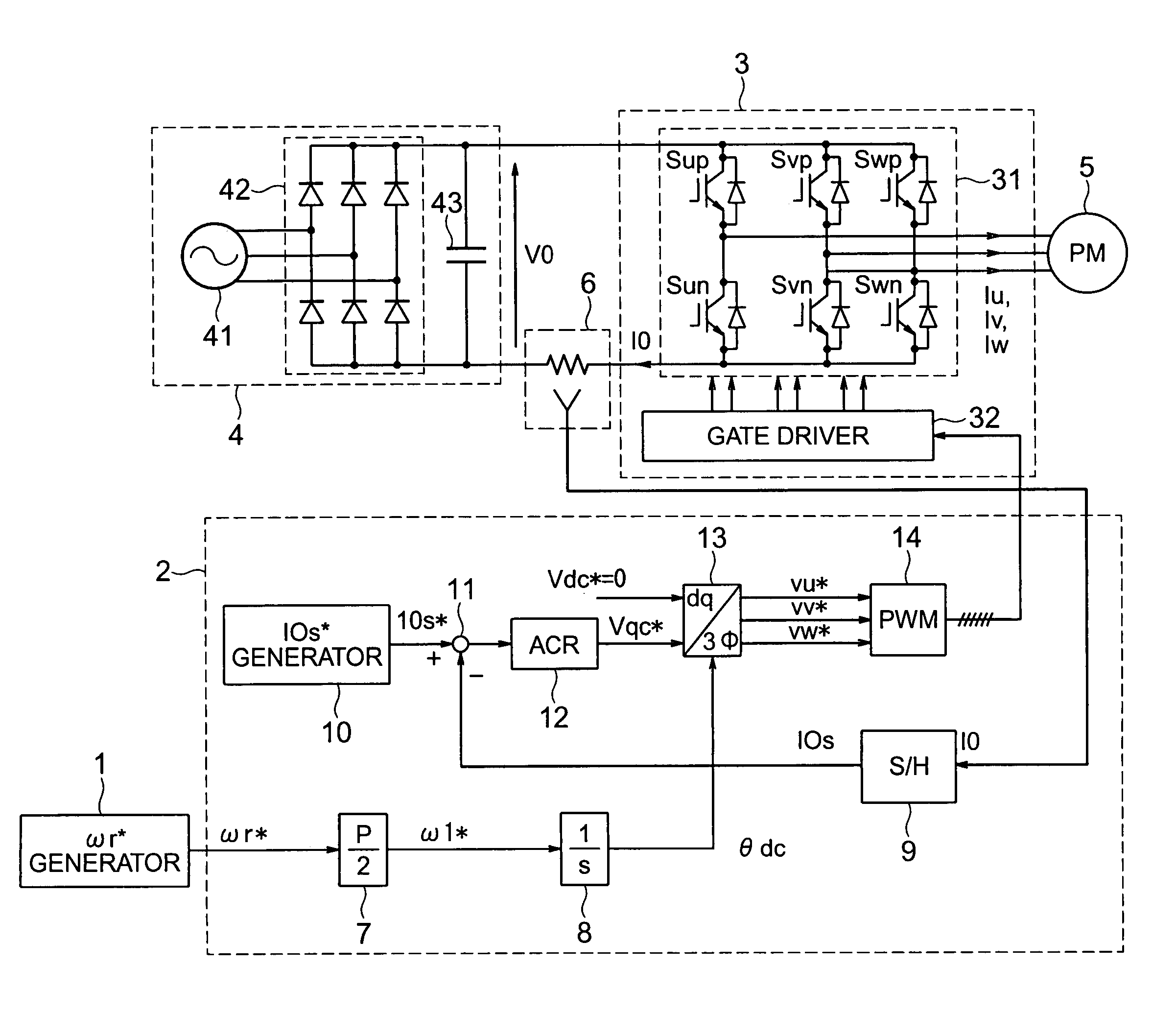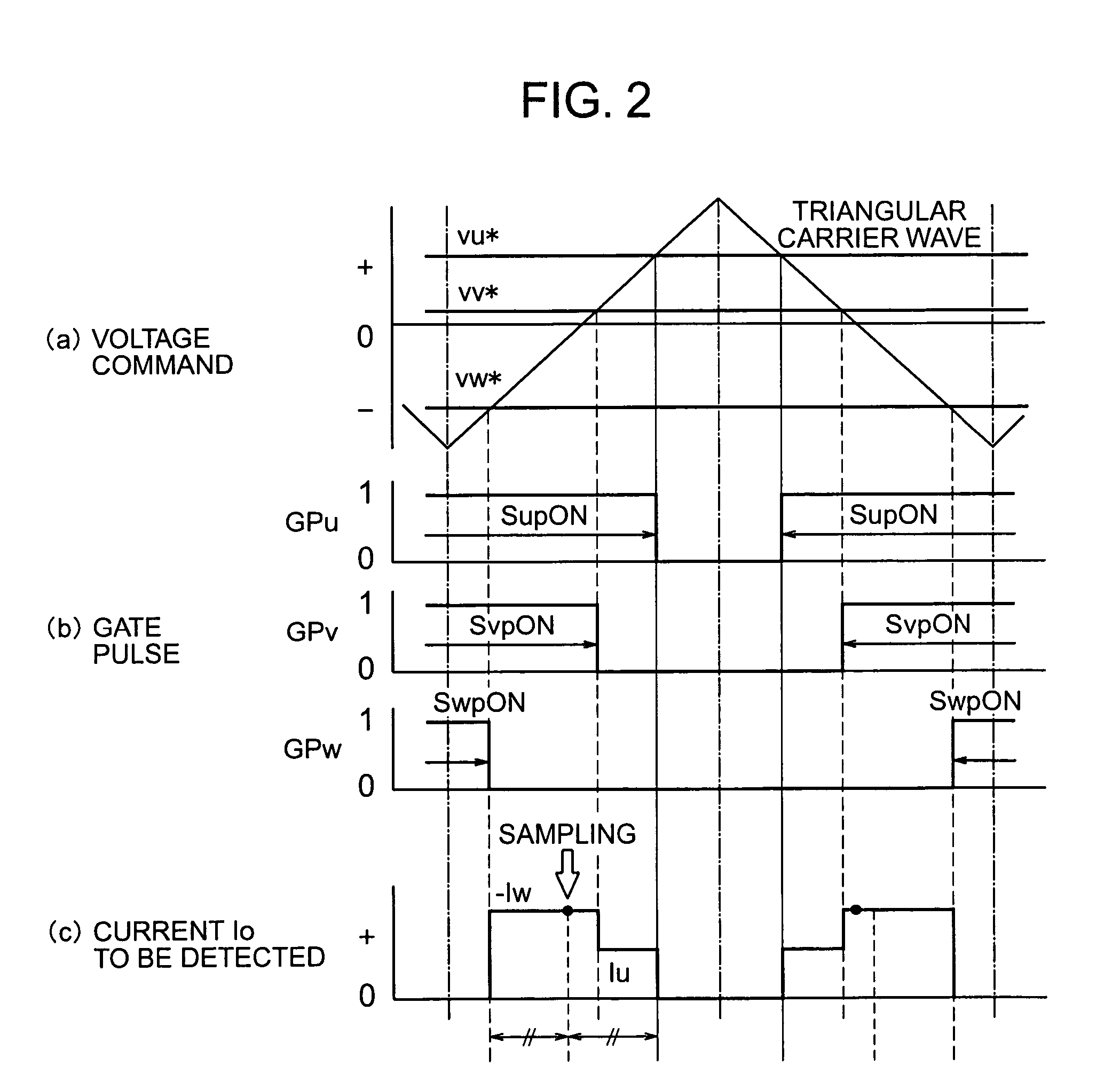Motor drive system for AC motors
a technology of ac motors and motor drives, which is applied in the direction of electronic commutators, dynamo-electric converter control, dynamo-electric gear control, etc., can solve the problems of difficult to capture a motor current component, difficult to reproduce a current, and extremely short gate pulses
- Summary
- Abstract
- Description
- Claims
- Application Information
AI Technical Summary
Benefits of technology
Problems solved by technology
Method used
Image
Examples
embodiment 1
(Embodiment 1)
[0028]FIG. 1 is a block diagram showing a system structure according to a first embodiment of an AC motor drive system of the present invention. A motor drive system of this embodiment comprises a rotation number command generator 1 for sending a rotation number command ωr* to a motor, a controller 2 for computing an AC voltage applied to the motor, converting it into a pulse-width-modulated signal (PWM signal), and outputting this PWM signal, an inverter 3 driven by this PWM signal, a DC power supply 4 for supplying electric power to the inverter 3, a permanent magnet type motor 5 as a controlling object, and a current detector 6 for detecting a current Ic supplied to the inverter 3.
[0029]The controller 2 comprises a conversion gain 7 for converting a rotation number command ωr* into an electrical angular frequency command ω1* of the motor 5 by using a pole number P of the motor, an integrator 8 for computing an AC phase θdc in the motor drive system, a current sample...
embodiment 2
(Embodiment 2)
[0049]Referring to FIG. 8, description will be made of a second embodiment of the present invention.
[0050]In the first embodiment, a current is provided in such a manner that the current flowing in the motor becomes a predetermined current value. In contrast, the second embodiment has as its object to detect a “reactive current” that flows in the motor to thereby control the motor with high performance.
[0051]FIG. 8 shows a block diagram of a controller 2A. Instead of the controller 2 in FIG. 1, the controller 2A in FIG. 8 is used which enables the second embodiment to be realized. In FIG. 8, the blocks which differentiate the second embodiment from the first embodiment are a filters 15 for los, aω1 compensator 16 that adds Δω1 to an electrical angular frequency command ω1* of the motor on the basis of output of the filter 15, and a voltage command computing unit 17 that decides a voltage applied to the motor from ω1*.
[0052]The controller 2A does not control the current...
embodiment 3
(Embodiment 3)
[0064]Referring to FIGS. 10 and 11, a third embodiment of the present invention will be described. FIGS. 10 and 11 show a method for detecting a reactive current and an example in which this method was applied to control.
[0065]FIG. 10 is a block diagram of a controller 2C. Instead of the controller 2 in FIG. 1, by using the controller 2C in FIG. 10, the third embodiment can be realized. In FIG. 10, the parts that differentiate the controller 2C from the controllers 2 and 2A in the above-mentioned embodiments are: an Ia·Ir computing unit 18 for computing at least one of the active current Ia and the reactive current Ir, which flow in the motor, from Ios; an interrupt generator 19 for generating an interrupt to start computing in the Ia·Ir* computing unit 18; and an Ir* generator 20 for giving a current command Ir* to the reactive current Ir.
[0066]Then, description will be made of the operation principle of the third embodiment. The Ia·Ir computing unit 18 computes an ac...
PUM
 Login to View More
Login to View More Abstract
Description
Claims
Application Information
 Login to View More
Login to View More - R&D
- Intellectual Property
- Life Sciences
- Materials
- Tech Scout
- Unparalleled Data Quality
- Higher Quality Content
- 60% Fewer Hallucinations
Browse by: Latest US Patents, China's latest patents, Technical Efficacy Thesaurus, Application Domain, Technology Topic, Popular Technical Reports.
© 2025 PatSnap. All rights reserved.Legal|Privacy policy|Modern Slavery Act Transparency Statement|Sitemap|About US| Contact US: help@patsnap.com



